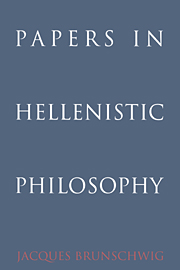Book contents
- Frontmatter
- Contents
- Acknowledgements
- Preface
- I EPICUREANISM
- II STOICISM
- 3 Remarks on the Stoic Theory of the proper noun
- 4 Remarks on the classification of simple propositions in Hellenistic logics
- 5 The conjunctive model
- 6 The Stoic theory of the supreme genus and Platonic ontology
- 7 On a Stoic way of not being
- 8 Did Diogenes of Babylon invent the Ontological Arugument?
- III SCEPTICISM
- Bibliography
- Index of subjects
- Index of names
- Index of passages cited
5 - The conjunctive model
Published online by Cambridge University Press: 25 October 2009
- Frontmatter
- Contents
- Acknowledgements
- Preface
- I EPICUREANISM
- II STOICISM
- 3 Remarks on the Stoic Theory of the proper noun
- 4 Remarks on the classification of simple propositions in Hellenistic logics
- 5 The conjunctive model
- 6 The Stoic theory of the supreme genus and Platonic ontology
- 7 On a Stoic way of not being
- 8 Did Diogenes of Babylon invent the Ontological Arugument?
- III SCEPTICISM
- Bibliography
- Index of subjects
- Index of names
- Index of passages cited
Summary
As we know, the conjunctive proposition, called συμπ∈πλ∈γμένον by the Stoic logicians, is a ‘non-simple proposition’, obtained by linking two or more propositions by the conjunction ‘and’. I should like to show that this conjunctive proposition constituted a sort of model in Stoic thought, by reason of the particular features of its truth-conditions. We shall find that the presence of this model may be detected in several different sectors of the Stoic system, – its physics, ethics, psychology and epistemology. I shall be trying to prove that the notion of the conjunctive model may illuminate a number of difficulties and obscurities in the dogmas of the school. If my proposed enquiry proves fruitful, we shall thus possess concrete means to verify the organic unity of Stoic philosophy in one specific instance. It is a unity that is frequently asserted by the Stoics themselves, as well as by their commentators, and is solemnly illustrated by the famous images of the orchard, the egg and the animal, but all too often it remains by and large elusive as an effective reality and so far as details are concerned.
First, it is worth pointing out that what I propose to call the ‘conjunctive model’ in point of fact already appears in certain expressions that the Stoics used to vaunt the systematic coherence of their doctrine.
- Type
- Chapter
- Information
- Papers in Hellenistic Philosophy , pp. 72 - 91Publisher: Cambridge University PressPrint publication year: 1994
- 2
- Cited by



